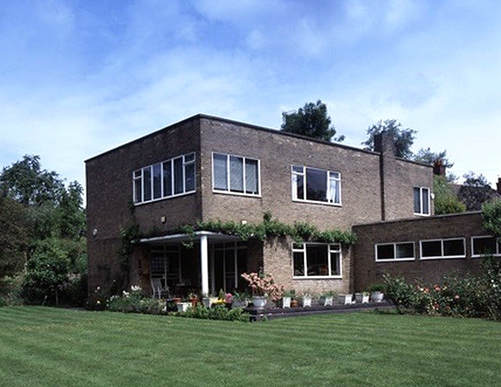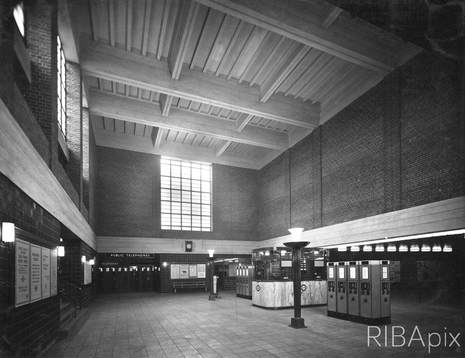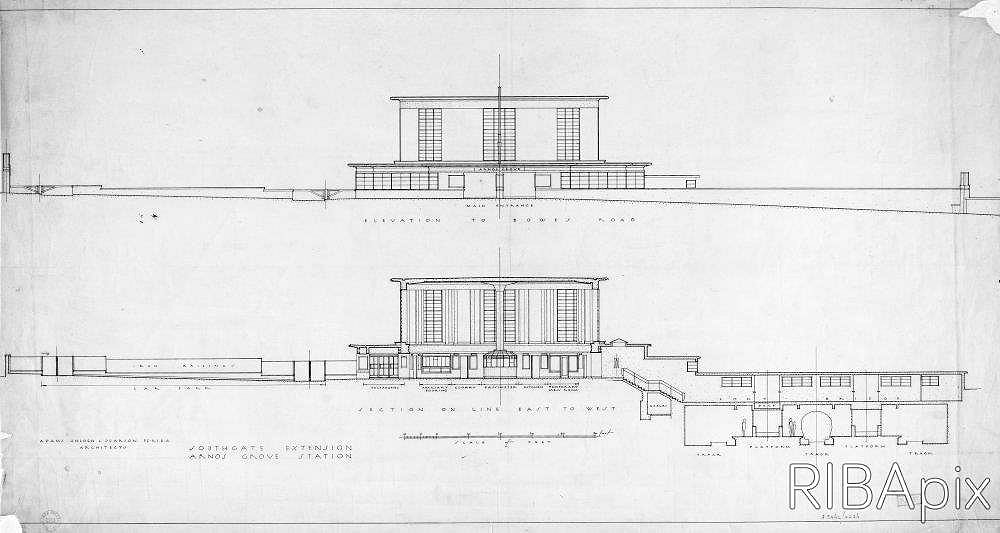|
Thank you to everyone who came on Saturday to our Open House London walking tour of Stanmore's Art Deco & Modernist houses. It was our biggest turn out in the three years of the tours, over 130 people! Thank you also to the home owners who answered our questions. Here are the tour notes for anyone that didn't manage to get a copy of the handout, plus a few vintage photos so you can compare what we saw to how the houses originally looked. Metroland Metro-Land was created by the extension of the Metropolitan Railway out of London and into Middlesex and the home counties. Land leftover from the construction of the new line was used for speculative housing, and formerly sleepy towns and villages like Wembley, Harrow, Pinner and Ruislip experienced a population boom in the first half of the 20th century.The default architectural style of these new leafy suburbs was Tudorbethan, as seen at nearby Canons Park. A mix of traditional styles on the exterior, matched by the comforts of modernity inside. Modernism was the upcoming style of the era, spreading to Britain from Europe. The houses we will see today, as well as other examples like Charles Holden’s tube stations and George Coles’ cinemas, brought art deco and international style modernism to the growing suburbs. Stanmore Stanmore also underwent a growth spurt after the new Metropolitan Railway (now Jubilee Line) terminus, designed by Charles W. Clark, was built in 1932. This area was part of the Warren House estate, founded by the first Duke of Chandos. In 1922 the house was inherited by Sir John Fitzgerald, and he decided to sell parcels of the land off for development. The company initially given the rights folded without building anything, with construction not taking place until the 1930’s. Kerry Avenue Architect Gerald Lacoste was given the commission to build houses on Kerry Avenue. These designs were intended to be part of larger modernist style estate, but 6 houses where the extent of the plan. Lacoste was only 27 at the time of the Kerry Avenue commissions and had previously been assistant to architects Edwin Lutyens and Oswald Milne. His six houses share many similar features with the Valencia Rd buildings; flat roofs, rounded staircase towers, white walls; but are more circumspect in appearance. The houses are designed to be similar as a group but not monotonous, using the same elements in differing arrangements. Like the Douglas Wood houses, the Kerry Ave buildings are constructed of brick, but have a mixture of exposed brick and snowcrete finishes. These houses were completed in 1937, and are now part of a conservation area along with the Valencia Road houses. Valencia Road The Valencia Road section was developed by Douglas Wood Architects. Although they were granted permission for development in 1931, the houses were not built until 1935. Nos. 2-10 were designed by the firm in the international modernist style with plain rendered walls, staircase towers and sun decks. The houses have an obvious vertical emphasis, with the staircase towers, vertical window strips and sun decks adding the bulk of the buildings, already emphasized by their position on a slope. The large windows and sun decks came from the growing awareness and fashionability of the health benefits of sunlight and sun bathing. The houses are constructed of brick and finished in snowcrete, which is a white cement used for rendering, to give the impression of concrete. Building the houses in brick probably happened because there was a shortage of building firms who had expertise in constructing in reinforced concrete in the 1930’s. Nos 4&6 were built as a symmetrical pair, and have rounded tower staircases. Nos 8 and 10 are also very similar to each other, whilst not quite being identical. No.2 was originally similar to its immediate neighbour, but has been altered. 14 & 16 Kerry Avenue At the northern end of Kerry Avenue are two individual modernist houses, No.14 designed by RH Uren for himself in 1937, and its neighbour No.16 designed by Gerd Kaufmann in 1968. No.14 is built in yellow brick in the international style similar to the other houses in the area. Uren was a New Zealand born architect who moved to Britain in 1930. His big break was his winning design for Hornsey Town Hall in 1933. He designed a number of other buildings in Britain, including Rayners Lane Tube station (1938) and the Granada Woolwich cinema (1937). No.16 is a much later building, designed and built in 1968 by the architect Gerd Kaufmann for Cherrill & Ian Scheer. Cherrill Scheer, heir to the Hille Furniture family, grew up at No.14. Like its neighbours, it is constructed of brick, with large windows to create differing light levels in each room. Kaufmann is known mainly for his suburban houses, with other examples here in Stanmore, as well as Mill Hill and Hampstead. Warren Fields Unrecognisable today, these twin apartment blocks were designed by architect and engineer Owen Williams and built in 1936. Designed in an austere fashion and built in concrete, the buildings have undergone successive refurbishments and extensions. Williams is not known for his domestic designs so it is a shame these buildings have ended up as they have. Halsbury Close Nos 1 & 2 Halsbury Close were designed by emigre architect Rudolf Frankel, who fled to Britain from Germany via Romania in 1933. No.1, built in 1938 for Frankel's sister, is made up of two brick cubes, one for a garage and one for the main house. The house also features a cut away corner that opens out onto the garden. No.2, built for himself also in 1938, is a simple box form finished in render and with tile hanging on the second floor. Frankel mainly produced industrial buildings in Britain, designing factories in London and Cheshire before moving to America in 1950. Aylmer Close
This close on the private Aylmer Road estate features a couple of interesting post war houses. No.1, designed by Edward Samuel in 1963, is a long low bungalow, built of brick, concrete and wood, and is Grade II listed. According to Wikipedia, Stanley Kubrick wanted to use the house in A Clockwork Orange.The owner, Ernest Shelton refused, and Kubrick instead used Team 4’s Skybreak House in Radlett. No.2 is a brutalist style concrete house, designed by Gerd Kaufmann in 1967, designer of No.16 Kerry Avenue, and it echoes in its design the 1930’s houses of Kerry Ave & Valencia Rd, which its circular staircase tower and flat roof.
0 Comments
Tuesday 19th September sees the 85th anniversary of the opening of the first five stations of the Cockfosters extension on the Piccadilly Line. These five stations; Manor House, Turnpike Lane, Wood Green, Bounds Green and Arnos Grove, were one of the first sets of modernist designed public buildings to be built in Britain. They also showcased the aesthetic qualities Charles Holden and Frank Pick, the CEO of the London Transport Passenger Board, had crafted since working together from the mid 1920’s. These stations were to act as adverts for the underground network; communicating modernity, speed and ease of use; as well as acting a civic hubs, integrating transport, commerce and even education. In this blog we will look at those first five stations and the the ideas that went into their design. The Piccadilly line opened in 1906, but by the mid 1920’s only extended from Finsbury Park to Hammersmith. Plans were made to extend the line, and after a delay due to WWI, work eventually began in the early 1930’s. Extensions were planned westward, to Uxbridge and Hounslow, and eastward to Cockfosters. Holden was put in overall charge of the designs of the stations on both extensions. The whole project was completed very quickly, from Holden being commissioned in April 1931 to completion of the first buildings in September 1932. Manor House The first station on the extension is Manor House. Manor House has a small above ground entrance and nine street level entrances, originally connected to a tram stop, which was cancelled in 1938. The stations most interesting design features are the ticket hall ceilings design of interlocking concentric circles, and the Harold Stabler ventilation grilles on the platform. Each station originally had these grilles, each supposedly representing the history and legends of each area. Turnpike Lane Turnpike Lane is the next station on the line.The station building is formed of a large square, a variation on Holden’s Sudbury Box, constructed in brick with two ventilation towers. The ticket hall is sunken, allowing access from the various pedestrian tunnels.The original design featured a bus station and tram stops, part of Pick’s vision of having an integrated transport network that serves as a civic hub. Indeed Turnpike Lane was Pick’s favourite underground station due to the success of the design in integrating the different above ground transport elements. The bus station was refurbished in the late 1990’s by the Rogers Partnership. Wood Green Unusually for Holden's Piccadilly Line stations, Wood Green is part of a parade. It was built between two existing 19th century buildings, and has a curved brick frontage with two ventilation towers, one having been extended at some point. Like all the stations on this extension it is constructed from a concrete frame infilled with Buckinghamshire multi-coloured face bricks. Unlike many of the Piccadilly line extension stations, the ticket hall is elliptically shaped rather than rectangular. The interior, which originally featured an exhibition space, has been altered from the original with the addition of the ticket offices on the southern end, and much of the interior fixtures and fittings are replacements. Bounds Green Bounds Green station was designed by architect C.H. James, who gave the station an octagonal ticket hall, another variation on Holden's ‘Sudbury Box’ design.The eight sided shape allows more windows in the ticket hall than other Holden stations. At the bottom of the escalators are bronze uplighters, originally found at all of the extension stations, but some have now been removed. The station was hit by a Luftwaffe bomb on October 13th 1940, and killing 19 people who were sheltering from an air raid. Stations of course were often used as air raid shelters during World War 2. Although Holden was responsible for the design of each station on the extension, quite often his involvement would be to visit the site and create a sketch of the above ground building and a basic plan, leaving others like Stanley Heaps and C.H. James to sort out the fine points such as the platforms and engineering details. Obviously with the building of so many stations so quickly it was necessary for Holden to delegate. Frank Pick had the final say on each design, before Holden passed them on to his assistants. Arnos Grove Arnos Grove station is considered by many to be Holden's masterpiece and one of the best buildings of the 20th century. It is formed of a circular booking hall on a square base, which was designed to allow passenger flow and creates an impressive interior space. A single concrete pillar supports the roof, with the original passimeter ticket office at the base. The booking hall also features original wooden telephone booths, which were restored in 2000. Holden's influence for his design here may have been Stockholm City Library, designed by Gunnar Asplund and visited by Pick and Holden on their 1930 trip, or possibly a groundsman's lodge in Midhurst designed by Holden in 1904. Despite all the accolades it was one of Frank Pick’s least favourite designs, and he approved the scheme only after much persuasion. Here as at Holden’s other stations can be seen his Arts and Crafts influence, through the care he takes in selecting and combining various different materials like brick, concrete, wood and glass. The new Piccadilly line stations were positively received by the contemporary architecture and general press, and even hosted a Royal visit with the prince of Wales (later Edward VIII) taking a ride between Wood Green and Hyde Park Corner. Of the five stations that were opened on 19th September 1932, only Manor House is not listed. The Piccadilly Line stations, particularity Arnos Grove and Southgate which opened in 1933, are looked on as the crowning achievements of Charles Holden and Frank Pick's efforts in creating works of high design that serve the public. Southgate and Oakwood opened on March 13th 1933, with Cockfosters becoming the last station on the extension on July 31 the same year. We will celebrate their anniversaries next year. |
Archives
May 2024
Categories |













 RSS Feed
RSS Feed